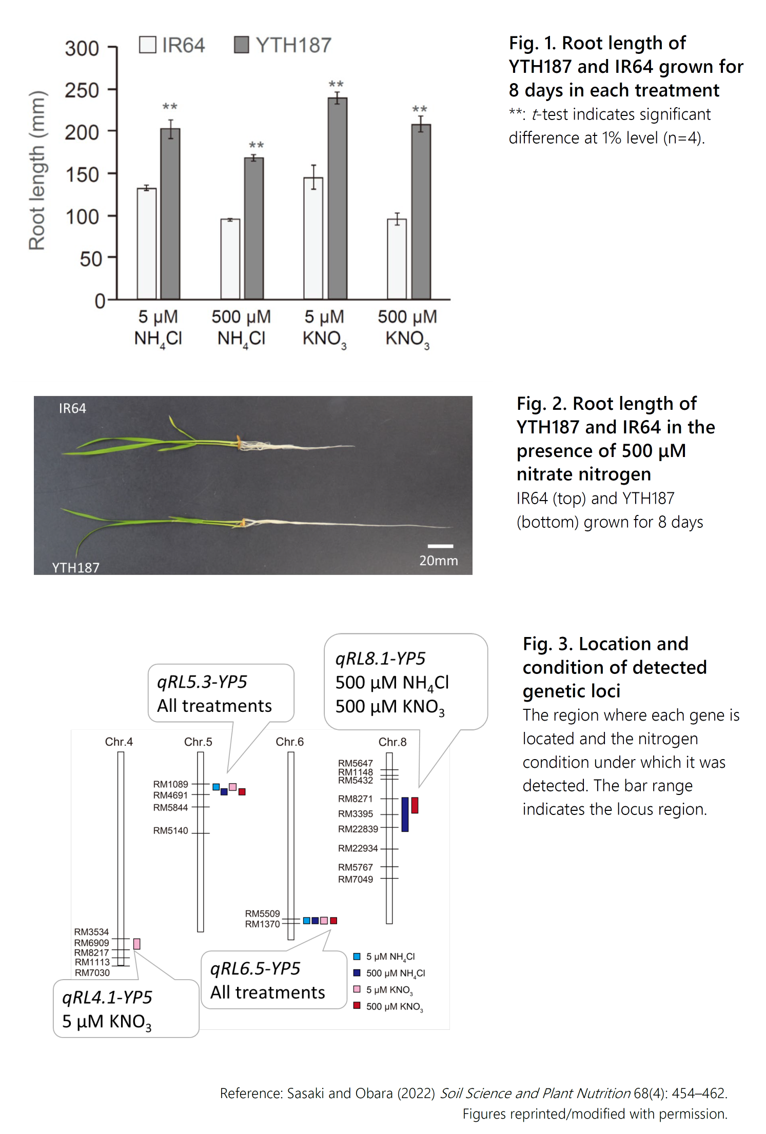Novel genetic loci that elongate rice roots under different nitrogen conditions
Description
To reduce the impact of nitrogen on the environment, it is expected that varieties with improved nitrogen utilization will be developed. One strategy to promote nitrogen utilization (uptake) is to improve the elongation of rice roots and increase the size of the root system. Therefore, identifying the loci involved in rice root length and develop DNA markers for line selection is crucial. The nitrogen available to rice varies with the growing environment. Under reducing waterlogged conditions (irrigated paddy fields), where irrigation water is available, ammonia-form is the main source of nitrogen supply. On the other hand, in rain-fed paddy fields and upland rice cultivation, which are prone to dry conditions and oxidative conditions, nitrate-form nitrogen may be the source of nitrogen supply. Therefore, to estimate the available cultivation conditions, it is necessary to set up experimental conditions in which ammonia-form nitrogen and nitrate-form nitrogen are the sole sources of nitrogen supply.
We set up four hydroponic conditions adjusted to 5 μM or 500 μM of NH4Cl as ammonia-form nitrogen and KNO3 as nitrate-form nitrogen. Line YTH187, which contains chromosomal fragments derived from IR69093-41-2-3-2 (YP5) in the genetic background of IR64, has a significantly longer root length than IR64 under all conditions (Figs. 1 and 2). Among the genetic loci that increase root length in YTH187, qRL4.1-YP5 is located between the molecular markers RM3534 and RM6909 on chromosome 4 and elongates roots only in the 5 μM nitrate-nitrogen condition (Fig. 3). These results suggest that it is effective in a nitrate-nitrogen-specific manner and may be effective in oxidative, low-fertility rainfed and upland rice fields. qRL8.1-YP5 (R2=0.09–0.16), located between RM8271 and RM3395 on chromosome 8, elongates roots under growing conditions with 500μM NH4Cl or KNO3. This result may be effective in irrigated and rainfed/upland rice cultivation with high nitrogen fertilization levels. qRL5.3-YP5 (R2=0.10–0.11) is located between RM1089 and RM4691 on chromosome 5 and elongates roots under all growing conditions. qRL6.5-YP5 (R2=0.12–0.22) is located between RM5509 and RM1370 on chromosome 6 and elongates roots under both low- and high-concentration root elongation under both nitrogen conditions. These results suggest that the two loci may be effective under a wide range of growing conditions.
The DNA marker information of qRL4.1-YP5, qRL5.3-YP5, qRL6.5-YP5, and qRL8.1-YP5 can be used for marker selection to improve the efficiency of nitrogen absorption through root morphology improvement. The effect was observed in the genetic background of IR64, which can contribute to the improvement of Indian-type cultivars grown in many tropical regions. The effects on root mass, nitrogen uptake, and productivity in the field need to be verified by growing near-isogenic lines carrying each locus alone.
Figure, table
- Research project
- Program name
- Term of research
-
FY2018–2022
- Responsible researcher
-
Sasaki Kazuhiro ( Biological Resources and Post-harvest Division )
KAKEN Researcher No.: 70513688Obara Mitsuhiro ( Biological Resources and Post-harvest Division )
- ほか
- Publication, etc.
-
Sasaki and Obara (2022) Soil Science and Plant Nutrition 68(4): 454–462.https://doi.org/10.1080/00380768.2022.2088030
- Japanese PDF
-
2022_B01_ja.pdf914.02 KB
- English PDF
-
2022_B01_en.pdf632.52 KB
* Affiliation at the time of implementation of the study.

